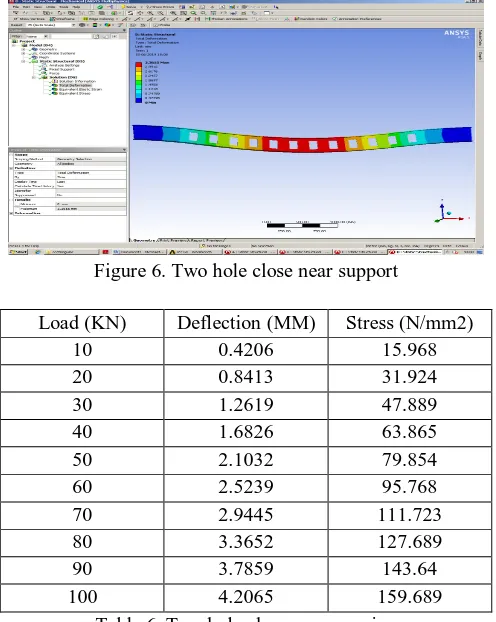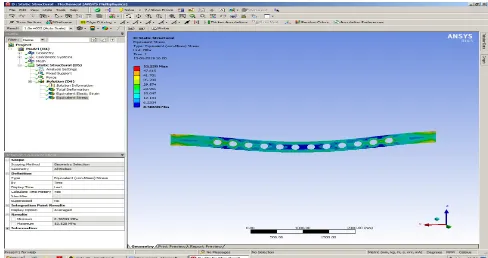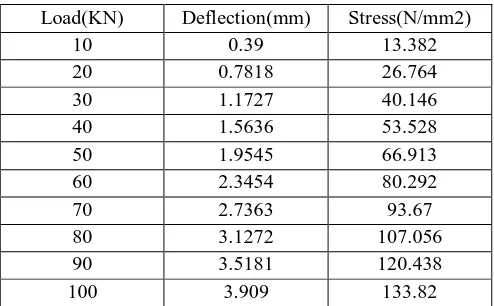Analysis and Design of Castellated Beam using
ANSYS
Naseem A. Ansari1, Dr. R. S. Talikoti2 1
M. Tech Student, 2Professor, Department of civil engineering, School Of Engineering And Technology, Nashik, India
Abstract: Castellated beam is the steel structure which are made by flame cutting rolled beam along with centreline than rejoining two halves by the welding so that overall depth increase by 1.5% for improved structural strength of using same quantity of material. The beam is a flexural member than maximum bending moment in middle portion and shear for maximum occurs at support, in castellated beam hole are made in the web portion with different shape, the surface of hole in inner side shear stress are induced due to shear force which are may cause to failure of beam or its start to fail from hole we produce by cutting, so reduce the shear stress we have to closed the cutting hole by refilling of same material up to specified span of beam. in this paper we have to we have to analysis of different shape of beam with refilling/close the castellated hole from both side of support. The study and analysis based on two parameter, first we have to analyse regular castellated beam in software and second parameter is to closed the hole of beam and analysis with same software and compare both the result which are obtain from beam.
Keywords: Castellated beam, shear zone, critical section, economical, castellated hole, ANSYS.
I. INTRODUCTION
Engineering are trying to make the structure economical and more safer to all the faluire condition this beam is one of the example of that. And continouse investigation and method is use to improve the strenght and servicibility of Castellated beam. Which is made of flame cutting of I-section through its center line in zig zog pattern after cutting we rejoining the helves of beam to prodece the shape of opening in the web of beam, generally Hexagonal, Squar, Rectangular, Cicular shape are used. This type of beam are more prefer for industrial building and now a day also used for small steel structure like Car parking, indoor stadium, foot over bridges etc. The depth of beam increase by 50% of its original depth, in design of structuural element there depth is play vital role for its servicibility and safety. Its main advantage is that depth of beam increase without the inceare the amount of steel which are make its cheap and light.other advantage of it that easy to assemble at site due to its light weight, good easthetic view, its use as a duct for supply the fire pipe, electric pipe, AC pipe etc.
II. OBJECTIVE
A. To increase the depths of beam without increase the amount of steel.
B. To reduce the cost of structure for the same building using these beam.
C. Make the structure economical.
D. Handling and installation of this type of structural element are easier due to its light weight.
E. It’s also gives the good aesthetics view as compare to cellular beam.
F. provide the pipe line for fire, electricity, Ac duct etc
G. Easy to assemble at site, painting, low maintenance etc.
III. MODEL DESCRIPTION
Two opening type of model has be Analysis by ANSYS software
A. Castellated beam with Rectangular opening
B. Castellated beam with Circular opening
In this paper deal with the six model of castellated beam.
1) Rectangular castellated beam Without hole close.
2) Rectangular castellated beam With 1hole close.
3) Rectangular castellated beam With 2hole close.
4) Circular castellated beam Without hole close.
5) Circular castellated beam With 1hole close.
Width of flange=Bf=100 mm Thickness of flange=Tf=10 mm Thickness of web=Tw=7.6 mm Height of section=H= 300 mm Length of section = 6000mm
IV. ANALYSIS AND RESULT
1) Case-1 Castellated beam with rectangular opening
Figure. Castellated beam with rectangular opening
Load Deflection stress
10 0.4705 25.8355
20 0.941 51.671
30 1.4116 77.506
40 1.8821 103.342
50 2.3526 129.177
60 2.8232 155.013
70 3.293 180.848
80 3.764 206.684
90 4.234 232.519
[image:2.612.183.428.501.638.2]100 4.7053 258.355
Table 4. rectangular opening without hole closing
2) Case-2 Rectangular beam with 1 hole close from both side of support.
Figure. Rectangular with 1 hole close from both side of support.
Load (KN) Deflection (mm) Stress (N/mm2)
10 0.4424 18.2965
20 0.8849 36.593
30 1.327 54.8895
50 2.2122 91.4825
60 2.6547 109.779
70 3.0971 128.0755
80 3.5396 146.372
90 3.982 164.6685
[image:3.612.181.427.76.163.2]100 4.4245 182.96
Table. One hole close near support of rectangular beam
3) Case-3 Two hole close near support of rectangular opening
Figure 6. Two hole close near support
Load (KN) Deflection (MM) Stress (N/mm2)
10 0.4206 15.968
20 0.8413 31.924
30 1.2619 47.889
40 1.6826 63.865
50 2.1032 79.854
60 2.5239 95.768
70 2.9445 111.723
80 3.3652 127.689
90 3.7859 143.64
[image:3.612.183.431.199.510.2]100 4.2065 159.689
Table 6. Two hole close near opening
4) Case-10 castellated beam with circle opening.
Figure. Castellated beam with circle opening.
Load (KN) Deflection(MM) Stress(N/mm2)
20 0.8326 36.65
30 1.249 54.975
40 1.6657 73.352
50 2.0817 91.615
60 2.498 109.976
70 2.9143 128.275
80 3.3307 146.65
90 3.747 164.925
[image:4.612.182.428.76.206.2]100 4.1634 183.25
Table. Castellated beam with circle opening.
5) Case-11 Circle opening with 1 hole close both side of beam
[image:4.612.186.427.239.374.2]Figure. Circle opening with 1 hole close both side of beam.
Load (KN) Deflection(mm) Stress(N/mm2)
10 0.4021 14.543
20 0.8042 29.08
30 1.2063 43.623
40 1.6084 58.186
50 2.0105 72.754
60 2.4126 87.245
70 2.8147 101.734
80 3.2168 116.324
90 3.6189 130.867
100 4.021 145.654
Table. Circle opening with 1 hole close both side of beam.
[image:4.612.182.430.403.554.2]6) Case-12 Circle opening with 2 hole close both side of beam.
[image:4.612.183.427.588.717.2]Load(KN) Deflection(mm) Stress(N/mm2)
10 0.39 13.382
20 0.7818 26.764
30 1.1727 40.146
40 1.5636 53.528
50 1.9545 66.913
60 2.3454 80.292
70 2.7363 93.67
80 3.1272 107.056
90 3.5181 120.438
[image:5.612.183.430.75.228.2]100 3.909 133.82
Table 12. Circle opening with 2 hole close both side of beam.
V. RESULT AND DISCUSSION
Best or economical castellated beam with there opening shape.
1) Castellated beam with Rectangular opening.
Load 2 hole closed 1closed hole Without hole closed
Deflection mm Stress N/mm2 Deflection mm Stress N/mm2 Deflection mm Stress N/mm2
100 KN 4.2065 159.689 4.4245 182.96 4.7053 258.355
2) Castellated beam with Circular opening.
Load 2 hole closed 1closed hole Without hole closed
Deflection mm Stress N/mm2 Deflection mm Stress N/mm2 Deflection mm Stress N/mm2
100 KN 3.909 133.823 4.021 145.654 4.1634 183.25
VI. CONCLUSIONS
Objective of this paper was reduce the stress at surface of castellated hole with the close the hole of shear zone of beam to avoid the shear failure of beam, we also observe that in result deflection of beam remains same or less with compare to without close the hole. The main reason to reduce the stress of beam by closing the castellated hole at support is that improve the bearing capacity of beam with same span and same size of hole. If we consider the rectangular opening without close hole stress is 258.355 N/mm2 after closing the 2 hole 159.689 N/mm2, stress is decrease by 98.666 N/mm2.
VII. ACKNOWLEDGMENT
I would like to express my deepest appreciation to all those who support me the possibility to complete this project. A special gratitude I give to my project manager, Dr. R. S. Talikoti, whose contribution in stimulating suggestions and encouragement, helped me to coordinate my project especially in writing this report.
REFERENCES
[1] “Structural Analysis and Design of Castellated Beam in Fixed Action” ,Ajim S Sheikh 1, prof. Pankaj. B. Autade, International Journal of Innovative Research In Advanced Engineering (IJIRAE),Issue 08, Volume 3 (August 2016).
[2] “Study of Positions of Stiffeners In Sinusoidal Castellated Beam”, Dighe Komal Govindrao*1, Prof.V. R. Rathi, International Journal of Engineering Sciences & Research Technology, February, 2017.
[3] “Parametric study of castellated beam with varying depth of web opening”, Wakchaure M.R. *, Sagade A.V.*, Auti V. A. International Journal of Scientific and Research Publications, Volume 2, Issue 8, August 2012.
[4] “Review on Study of Castellated Beam with&without Stiffeners”, Miss. Pooja P. Rugge Prof. Pallavi K. Pasnur, IJSTE - International Journal of Science Technology & Engineering | Volume 3 | Issue 09 | March 2017.
[5] “Improving Behavior of Castellated Beam by Adding Spacer Plat and Steel Rings”, Hayder Al-Thabhawee, Muslim Al-Kannoon, Journal of University of Babylon, Engineering Sciences, Vol.(26), No.(4): 2018.
[6] “Finite Element Analysis of Castellated Beam: A Review”, A. M. Jamadar P. D. Kumbhar, International Journal of Innovative Research in Advanced Engineering (IJIRAE) ISSN: 2349-2163 Volume 1 Issue 9 (October 2014).



